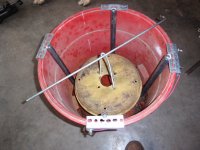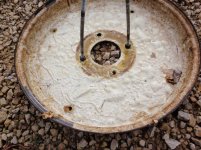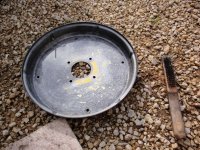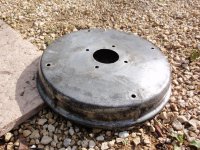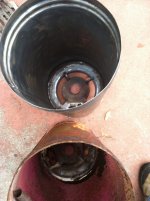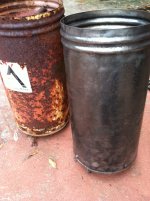You are using an out of date browser. It may not display this or other websites correctly.
You should upgrade or use an alternative browser.
You should upgrade or use an alternative browser.
Electrolytic Rust Removal
- Thread starter Iplayfarmer
- Start date
/ Electrolytic Rust Removal
#11
CNC Dan
Veteran Member
Iplayfarmer said:Does temperature have anything to do with the rate of the process? It got pretty cold overnight.
Yep. Chemical reactions are faster at higher temps.
HCJtractor
Veteran Member
- Joined
- Jan 28, 2009
- Messages
- 1,544
- Location
- upstate South Carolina, Greenville
- Tractor
- Kubota M6800, Massey Ferguson 240
It's an amazing process. No need to use clean water as stated. Process is "line of sight" so must use multiple electrodes on all sides including the inside. Item cannot touch the container, electrodes, or sediment. I used a battery charger (2/10/50 amp) and used the middle setting. Let it sit overnight, remove, brush with a stiff bristle brush, and repeat if necessary. You can tell it is working by the thousands of tiny bubbles rising to the surface. And sodium carbonate is what to use, not bicarbonate.
Attachments
muddstopper
Veteran Member
I dont know what is in Arm and Hammer washing soap, but the mineral you want to use is borax, not sodium carbonate or bicarbonate of soda. Twenty Mule Team Borax washing soap would my suggested alternative to the Arm and Hammer, unless the Arm and Hammer also contains borax.
Just to note, I have not tried sodium carbonate so I cant say if it will or will not work. I suspect it might as there are a lot of minerals that will increase conductivity to water and will work to some degree, some better than others and some not so good. My experiences are that I have had good luck with the borax cleaning the inside of a 1000 gal hydroseeding tank using a welder, (DC),as a power source. Dont remember what setting the welder was on but I started low and dont remember raiseing the setting.
Just to note, I have not tried sodium carbonate so I cant say if it will or will not work. I suspect it might as there are a lot of minerals that will increase conductivity to water and will work to some degree, some better than others and some not so good. My experiences are that I have had good luck with the borax cleaning the inside of a 1000 gal hydroseeding tank using a welder, (DC),as a power source. Dont remember what setting the welder was on but I started low and dont remember raiseing the setting.
HCJtractor
Veteran Member
- Joined
- Jan 28, 2009
- Messages
- 1,544
- Location
- upstate South Carolina, Greenville
- Tractor
- Kubota M6800, Massey Ferguson 240
All info I have read and researched from multiple places calls for sodium carbonate. I can't speak for borax, but have used the sodium carbonate and know it works. I bought it online in a 5 lb. quantity. It's used in some cooking techniques ( pretzels, I think), also available from what I have read at swimming pool chemical stores, and in the form of "washing powder" from Arm and hammer, but I never found that product locally. All sources emphasize not to use standard baking soda (sodium bicarbonate). I googled it and found it easily and it is cheap! I agree that other chemical solutions that are conductive may also work, but I can attest to the effectiveness of Na carbonate. There's lots of info on this technique if you google "electrolytic rust removal."
It is an amazing process and is so simple . Rig a plastic drum or trash can like the one in a previous post. I used rebar connected with copper wire as my sacrificial electrodes. The rust and old paint can be just wiped off with almost no effort. The before/after pix I posted of those old hoppers, although soaked overnight for 2 days, took me less than 5 minutes of easy brushing get looking like that. And it doesn't harm chrome (unless undermined by rust). Best of all, it costs only pennies, and produces no chemical waste, just rusty water.
It is an amazing process and is so simple . Rig a plastic drum or trash can like the one in a previous post. I used rebar connected with copper wire as my sacrificial electrodes. The rust and old paint can be just wiped off with almost no effort. The before/after pix I posted of those old hoppers, although soaked overnight for 2 days, took me less than 5 minutes of easy brushing get looking like that. And it doesn't harm chrome (unless undermined by rust). Best of all, it costs only pennies, and produces no chemical waste, just rusty water.
Iplayfarmer
Super Member
I tried to upload some pictures from yesterday morning, but I'm having issues. The sacrificial piece was covered in a loose scaly rust, so I'm getting rust from somewhere. I think the pot is just so corroded that it's going to take some time. I tried putting a bolt down into the middle of the pot to be my anode. After all day at work, there was very little change. I think it may have something to do with the smaller surface area of the bolt vs. the larger plate. I went back to the plate for now and I'll leave it for another day or so and see what kind of change I see on the outside of the kettle.
I may see if I can rig a piece of tube or pipe to be my internal electrode. That would give me more surface area.
I may see if I can rig a piece of tube or pipe to be my internal electrode. That would give me more surface area.
Soundguy
Old Timer
- Joined
- Mar 11, 2002
- Messages
- 52,238
- Location
- Central florida
- Tractor
- RK 55HC,ym1700, NH7610S, Ford 8N, 2N, NAA, 660, 850 x2, 541, 950, 941D, 951, 2000, 3000, 4000, 4600, 5000, 740, IH 'C' 'H', CUB, John Deere 'B', allis 'G', case VAC
yes.. sodium carbonate is the prefered electrolyte.
( bicarb can pit the metal )
( lye is too dangerous to use )
as was stated.. more is better.
12v is better than 6.
10a seems to be a great start. I have used 20
distance from ANODES to work piece matters as well. closer = more current flow.
( bicarb can pit the metal )
( lye is too dangerous to use )
as was stated.. more is better.
12v is better than 6.
10a seems to be a great start. I have used 20
distance from ANODES to work piece matters as well. closer = more current flow.
HCJtractor
Veteran Member
- Joined
- Jan 28, 2009
- Messages
- 1,544
- Location
- upstate South Carolina, Greenville
- Tractor
- Kubota M6800, Massey Ferguson 240
I agree you need way more surface area on the inside. You want lots of electrodes, spaced evenly, on all sides. And let it work overnight, then remove, brush and rinse the item, and use a long handle wire brush (like a grill cleaning brush) to quickly clean off the electrodes somewhat just to refresh them. Then repeat. My pictures of the seed hoppers took two overnight soakings to get that clean. Sounds like you need to improve your tub and make sure all the connections are good, and that there is more surface area of electrodes, and that they are more closely spaced. And perhaps some battery chargers may work better than others. I know some don't put out continuous current if they have internal "brains" that may be shutting off current when they sense weird flow. Mine is just a simple Schumaker manual one without an auto shut off feature. The key is the bubbles. If it's not bubbling, it's not working. (but bubbles are tiny, but profuse)
Soundguy
Old Timer
- Joined
- Mar 11, 2002
- Messages
- 52,238
- Location
- Central florida
- Tractor
- RK 55HC,ym1700, NH7610S, Ford 8N, 2N, NAA, 660, 850 x2, 541, 950, 941D, 951, 2000, 3000, 4000, 4600, 5000, 740, IH 'C' 'H', CUB, John Deere 'B', allis 'G', case VAC
yup.. 'dumb' chargers are the ones to use.

